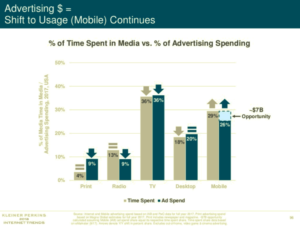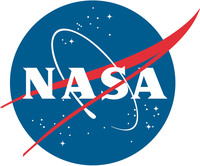Trends marketers should be paying attention to in the year ahead.
Advertising wasn’t a major focus of Mary Meeker’s Internet Trends report this year, but the well-known internet analyst pointed out several interesting developments that affect the sector. Here we lay out some of the opportunities and challenges that lie ahead for the digital advertising ecosystem.
Opportunities
The time we spend on our connected devices keeps rising. Daily digital media usage among adults now comes in at 5.9 hours, and the majority of that time is spent on mobile devices. We’re hooked. In fact, mobile is the only medium that users increased time with compared to the previous year.
And yet with all the innovation in experience, formats and measurement, marketers are still underallocating ad dollars to mobile in relation to time spent. Users spend 29 percent of their media time on mobile, while advertisers only allocate 26 percent of budgets to mobile.
That gap has shrunk in the past few years, ago, but Meeker suggests there is still a $7 billion opportunity for mobile media spend. That also means mobile ads continue to come at a relative discount. Print, TV and desktop ad spend all remain overindexed in relation to time spent.
What’s missing from the chart above? Voice devices. The number of devices installed in homes skyrocketed in 2017. And where scale goes, ad dollars follow.
From goods and services to sell to apps/skills to develop, voice devices offer a new frontier for advertisers and marketers — and an opportunity to get the balance right and learn from mistakes made on web and mobile.
We’re just starting to see the first iterations of ad formats with Google Shopping Actions, Google’s foray into monetizing voice search on Google Home devices and Google Assistant. That solution is priced on a cost-per-sale basis.
Meeker focused extensively on e-commerce in the report this year (see our coverage of the key e-commerce trends), but in terms of e-commerce-driven advertising, the behemoths still have more room to run. Amazon may be the most interesting to watch over the next year as its ad business is starting to take off.
Citing Morgan Stanley research, the report indicated that Amazon’s ad revenue topped $4 billion in 2017, up 42 percent year over year. The company’s ad platforms, Amazon Marketing Services (AMS) and Amazon Media Group (AMG), are both poised for growth.
The question is whether Amazon will start to siphon ad budgets that currently go to Google and/or Facebook, or if the three ships will all continue to rise.
Threats
Now let’s look at some of the threats and challenges that popped up through the report.
Artificial Intelligence (AI) now underpins most of the current innovation in advertising. As consumers and new regulations prioritize privacy, there is the prospect of less data being available to fuel AI-powered personalization and campaign optimizations.
Concerns about brand safety and the integrity of platforms in the era of fake news, bots and offensive UGC has caused major advertisers to rethink their digital strategies. There’s also the fact that the market is dominated by two players — Amazon’s ascendance as it brings advertising to its commerce platform is of little comfort to the likes of Snapchat, Pinterest and even publishers trying to scale their own ad businesses.
Then there are macro trends. There is nothing like a comparison to 2008 to make you shudder:
The US is at near full employment (as of today pegged at just 3.8%), but household debt is now higher than it was ahead of the great recession, driven by housing, student loans and auto expenses. Personal savings rates are falling, and the debt-to-annual-income ratio is rising.
Meeker highlighted high and improving consumer confidence. Consumer confidence was also high in 2007:
Zooming back into the advertising landscape, pricing increases and higher costs to acquire new customers from advertising is causing marketers to rethink measurement.
Customer lifetime value is the new metric of choice, according to a Salesforce survey. To end on a positive note, 2017 can likely be looked back on as the tail end of the dominance of last-click attribution.




